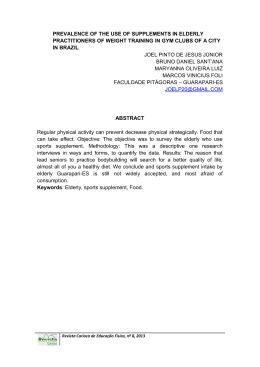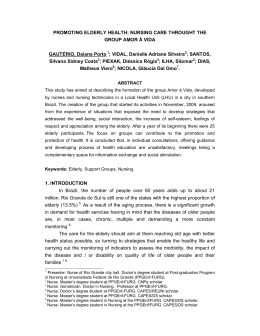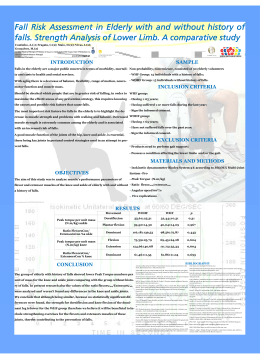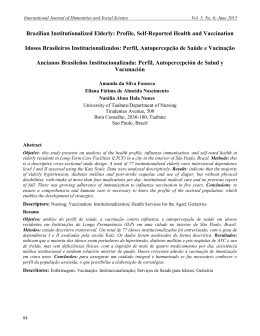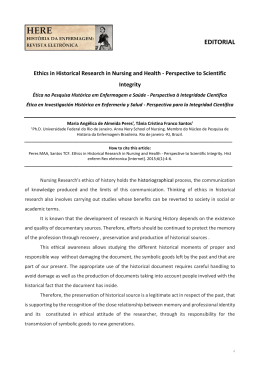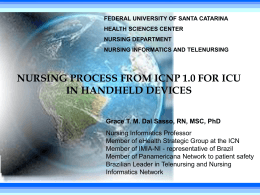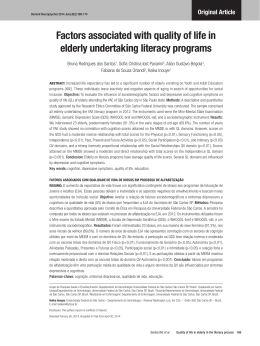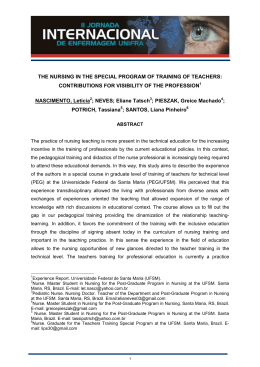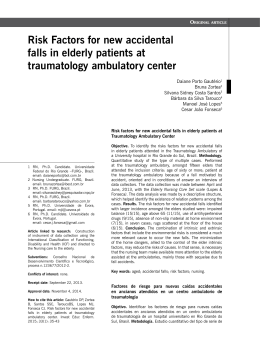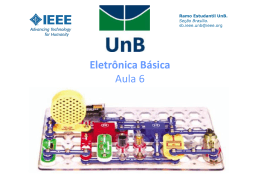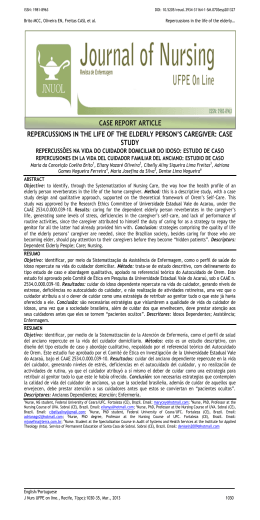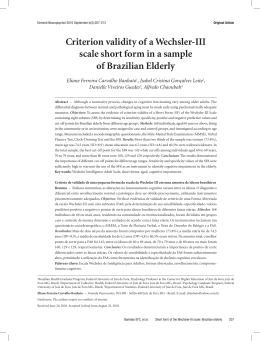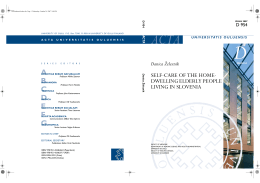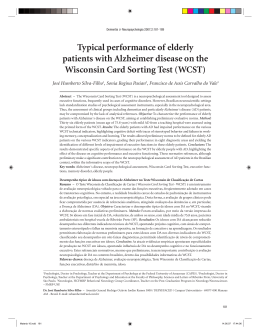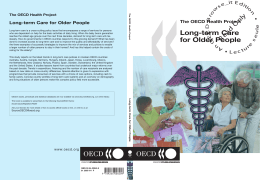ISSN 2175-5361 DOI: 10.9789/2175-5361.2014v6n1p398 Schulz RS, Santana RF, Faleiro TB, et al. Need to move and maintain… RESEARCH Need to move and maintain a good posture in elderly on surgery: quasi-experimental study Necessidade de movimentar-se e manter uma boa postura no idoso cirúrgico: quase-experimento Necesidad del anciano quirúrgico de moverse y mantener una buena postura: casi-experimento Renata da Silva Schulz 1 , Rosimere Ferreira Santana 2 , Thiago Batista Faleiro 3 , Magali Rezende de Carvalho 4 , Raquel Calado da Silva Gonçalves 5 , Luise de Almeida Ferreira Alves 6 ABSTRACT Objective: To identify in elderly people on surgery the need to move and maintain desirable postures; to evaluate the outcome of interventions for the need in a study group. Method: This is a quantitative and quasi-experimental study, conducted with 30 elderly in the postoperative in hospital in Rio de Janeiro. It was used for data collection the protocol for evaluation of basic needs second Virginia Henderson and for the experimental group was used the healthcare. Results: The main needs identified were painful to jogging, decreased joint flexibility, bed restriction, balance disorders, decreased strength and muscular endurance. From the 40 identified needs in the experimental group could be reduced 8 and in the control group from 35 were reduced to 3, obtained Oddis Ratio (0R) of 2,66. Conclusion: There was significant improvement in the experimental group and the reduction of the identified problems when compared to the control group. Descriptors: Aged, Mobility Limitation, Nursing Care. RESUMO Objetivos: Identificar em idosos cirúrgicos a necessidade de movimentar-se e manter uma boa postura; avaliar o desfecho das intervenções para a necessidade de movimentar-se em um grupo experimento e controle. Método: Trata-se de uma pesquisa quantitativa, quase experimental, aplicada a 30 idosos em pós-operatório num hospital localizado no Rio de Janeiro. Utilizou-se como instrumento de coleta dos dados um protocolo de avaliação das necessidades básicas segundo Virginia Henderson e ao grupo experimento aplicou-se intervenções. Resultados: As principais necessidades identificadas foram dores ao movimentar, diminuição da flexibilidade das articulações, restrição ao leito, déficit de equilíbrio, diminuição da força e da resistência muscular. Das 40 necessidades identificadas no grupo experimento conseguiu-se reduzir 8 e no controle das 35 necessidades identificadas houve redução de 3, obtendo-se Oddis Ratio (0R) de 2,66. Conclusão: Houve melhora significativa no grupo experimento quanto a redução dos problemas identificados quando comparado ao grupo controle. Descritores: Idoso, Limitação da mobilidade, Cuidados de enfermagem. RESUMEN Objetivo: Identificar en ancianos quirúrgicos la necesidad de moverse y mantener una Buena Postura; evaluar la conclusión de las intervenciones para la necesidad de moverse en los grupos. Método: Investigación cuantitativa, casi-experimental, aplicada a 30 ancianos en pos-operatorio en un hospital de Rio de Janeiro. Como instrumento de recolecta se empleó un protocolo de evaluación de necesidades básicas según Virginia Henderson y se aplicaron las intervenciones al grupo experimento. Resultados: Se identificaron como principales necesidades: dolores al moverse, reducción de flexibilidad articular, restricción al lecho, déficit de equilibrio, reducción de fuerza y resistencia muscular. De las 40 necesidades identificadas en el grupo experimento, se consiguió reducir 8 y en el control, de las 35 se redujo a 3, obtuvo una Oddis Ratio (OR) de 2,66. Conclusión: Se verificó mejoría en el grupo experimento respecto a la reducción de los problemas identificados cuando se comparó al grupo-control. Descriptores: Anciano, Limitación de la movilidad, Cuidados de enfermería. 1 Surgical Clinical Nurse Specialist in the State University of Rio de Janeiro-UERJ. Rio de Janeiro (RJ), Brazil. E-mail: [email protected]. 2Post doctorate in Nursing, Assistant Professor, School of Nursing Aurora de Afonso Costa (EEAAC), Federal Fluminene University(UFF). Niterói (RJ), Brazil. E-mail: [email protected]. 3Orthopedist. Member of the Brazilian Society of Orthopedics and Traumatology. Rio de Janeiro (RJ), Brazil. E-mail: [email protected]. 4Nurse Postgraduate in Wound, Ostomy&Continence by R.B. Turnbull School of WOC Nursing, Cleveland Clinic Foundation, Cleveland, Ohio, United States. E-mail: [email protected]. 5Nurse Specialist in CC, RPA and CME at the University Gama Filho. Rio de Janeiro (RJ), Brazil. E-mail: [email protected]. 6Nurse Specialist in Oncology at the National Cancer Institute/INCA. Rio de Janeiro (RJ), Brazil. E-mail: [email protected]. J. res.: fundam. care. online 2014. jan./mar. 6(1):398-407 398 ISSN 2175-5361 DOI: 10.9789/2175-5361.2014v6n1p398 Schulz RS, Santana RF, Faleiro TB, et al. Need to move and maintain… INTRODUCTION T he problems related to the musculoskeletal system usually do not involve risk of life, but have a significant effect on the normal activities of the patient and productive.1 The need to move is affected by some factors essential for execution of ABVD (Basic Activities of Daily Living) and IADL (Instrumental Activities of Daily Living) involving: strength, power, flexibility, balance, agility and aerobic endurance.2,3 However, many of the detrimental effects of aging may be compensated when the body is kept healthy by adopting an active lifestyle and maintaining functional capacity.4,5 In this perspective, while aerobic exercises help in the prevention of chronic diseases such as cardiovascular disease, strength training in elderly post-surgical, by adding a good muscle tone, has been the primary method of intervention to maintain functional independence.4,6 When the elderly requires a hospital stay and the risk of prolonging your recovery for the immobilization in bed favors the installation of hospital infections, decubitus ulcers, respiratory, vascular and neuropsychiatric.7 Given the hospitalized elderly client, exacerbations and chronic complications associated with changes due to aging, subject to re-admissions. Approximately 50% of hospital beds are occupied by people over 60. The high cost of health care in this stage of life, 3-7 times more expensive than the average population, represents a challenge to health services.8 Therefore, it was decided in this study the theory of Virginia Henderson, who is 14 fundamental needs for the satisfaction of individuals. Among the requirements of the theory applied gerontology highlight the "move-up and maintain good posture". The deleterious effects of immobilization in bed, as well as the impact of such effects on the functional capabilities of individuals with postoperative outlined the following objectives: to identify the need for surgical elderly Jogging and Maintain Good Posture, and evaluate the outcomes of interventions to the need for jogging in a experimental group and control. J. res.: fundam. care. online 2014. jan./mar. 6(1):398-407 399 ISSN 2175-5361 DOI: 10.9789/2175-5361.2014v6n1p398 Schulz RS, Santana RF, Faleiro TB, et al. Need to move and maintain… METHODOLOGY It is a search for a quantitative approach, quasi-experimental design with anteriorposterior, involving nursing interventions in need Jogging and Maintain good posture in elderly surgical patients. The subjects were observed before and after the implementation of nursing interventions appropriate to each case individually, proposed by the International Classification of Nursing. The study site has been in the surgical clinics of the University Hospital of the State of Rio de Janeiro, in the period January-April 2010. The participants of the study, 30 elderly customers were allocated by simple randomization from drawing into two groups, 15 in the experimental group and 15 in control. Customers were under the supervision of several surgical specialties (general surgery, orthopedics, vascular surgery and neurosurgery). The subjects were selected, independent of the type of surgery, because of their low functionality in BADL and IADL scales identified by Katz and Lawton respectively. It was adopted as a criterion for inclusion was dependent on the scales of Lawton and Katz, have a caregiver, having more than 65 years. And as exclusion criteria: suspension of surgery, do not participate in any of the assessments proposed. There were selected as study variables: individual characteristics of the subjects (sex, age, marital status, education level) and surgical diagnosis. And as intervening variable, nursing interventions to meet the basic human need (BHN) of Jogging and maintain good posture. Applied subject to a protocol to identify needs, it is a closed protocol with items identifying problems met by the professional as an example we quote: decreased muscle strength and endurance, presence of muscle pain, decreased joint flexibility; intolerance activity, balance, posture and gait irregular decreased neuromuscular coordination, among others who were based in Virginia Henderson, the form and content validated by experts in the field of nursing fundamentals and working in nursing research. As a strategy for data collection proceeded with the following steps: 1) Clinical nursing to identify the main issues involved in the need to move and maintain good posture. This applied to the subjects of both groups on the first postoperative day and the end of his hospitalization, featuring the design is not equivalent anterior-posterior, in a total of 60 ratings. We used an average of 20 minutes for each client during the clinical examination of nursing. 2) A protocol was created individualized care for each patient in the experimental group, according to the problems identified in the initial assessment. Nursing interventions were based on the International Classification of Nursing (Nursing International Classification-NIC), selected to promote health of the individual, avoiding possible risks and providing improved functions for each identified need. The interventions were performed by the research team 3 times a day, throughout the period of hospitalization. Care had an average duration of 40 minutes. During the J. res.: fundam. care. online 2014. jan./mar. 6(1):398-407 400 ISSN 2175-5361 DOI: 10.9789/2175-5361.2014v6n1p398 Schulz RS, Santana RF, Faleiro TB, et al. Need to move and maintain… interventions was promoted health education for caregivers. These actions are taught the correct way to perform the appropriate care seeking home segment. The implementation of the continuum (intervening variable) was held only in the experimental group. However, members of the control group received routine care prescribed by the work of the surgical units of local search. Nursing interventions performed with patients in the experimental group, briefly, were as follows: a) Interventions for muscle relaxation: Offering a comfortable position for the patient to initiate the procedure; Isometric contraction of the muscles of the feet for no more than five seconds to prevent cramps; Advise the patient to focus on the sensations in the muscles contracted and while also relaxed; Advise the patient to breathe deeply and slowly exhale and relieve tension while performing the procedure; Use proper body mechanics in the correct alignment during movement. b) Interventions for the transfer: Assist the patient to ambulate using the human body as a crutch, as appropriate, assist the patient to sit and stand; Advise the patient/caregiver on how to systematically perform range of motion exercises assets, liabilities or assisted ambulation Encourage adequate; Encourage sitting on the bed, on the side (with legs dangling), or chair as tolerated. The analysis of data was so descriptive and inferential statistics, was used for both the statistical test Oddis Ratio (OR) in the comparative analysis of the groups. Note that it respected the ethical aspects in accordance with Resolution 196/96 of the National Health Council, including signing the elderly and/or legal guardian of the Instrument of Consent. The research has a favorable opinion of the Ethics Committee in Research of the Faculty of Medicine/University Hospital Antonio Pedro, being registered as CAAE nº. 0090.0.258.000-07. RESULTS AND DISCUSSION According to the characteristics of the sample of 30 elderly clients waged most are women (70%), with age distribution between 65 to 86 years, as shown in Figure 1. Regarding income 87% were retired and 13% pensioners, but it was noted that 21 of them were not able to manage your finances by transferring this responsibility to one of his relatives. J. res.: fundam. care. online 2014. jan./mar. 6(1):398-407 401 ISSN 2175-5361 DOI: 10.9789/2175-5361.2014v6n1p398 Schulz RS, Santana RF, Faleiro TB, et al. Need to move and maintain… Graph 1: Number of seniors by age group: Source: Field survey - Niterói - January to April 2010. Relating to education, the majority 51% had incomplete primary school, 20% completed high school, 13% illiterate; 7% primary school, and only 3% completed the third grade. With regard to marital status, 49% were married, 27% widowed, 17% were single and 7% divorced. It is noteworthy that proportionally the number of married elderly men was higher than that of married elderly women. Regarding the diagnosis that led to the hospitalization process the number of cases of cancer and fractures was significantly higher with 39% and 21%, respectively. The remaining percentages were related to vascular problems, cholelithiasis, pleural effusion, and umbilical hernia herniated disc. In relation to sensory deficits had in 80% of patients and visual deficits, 17% of hearing deficits. In relation to data accompanying it was found that the majority were females, the number of women accounted for 97% (29) of caregivers analyzed. The number of daughters caregivers highlighted in this analysis had 38%, followed by 14% the number of sisters, granddaughters, 13%, 10% wives, and neighbors 10%. In the other percentages are included other types of degrees such as family coined 3%, 3% niece, girlfriend 3%, caregiver without family ties 3% and 3% brother. After comparative analysis showed that of the 40 needs identified in the experimental group could be reduced 8 and in the control 35 of identified needs were reduced by 3. Table 1 highlights the main problems encountered in the research. Table 1: Problems identified before and after nursing interventions on the need to move and maintain good posture. HUAP, RJ, (January-April), 2010. PROBLEMS IDENTIFIED GROUP EXPERIMENT CONTROL GROUP Postoperative High Postoperative High Pain when moving 10 7 11 9 Decreased flexibility in joints 6 4 8 7 Restriction to bed 6 6 5 5 Balance deficit 5 5 3 3 Decreased muscle strength and endurance 4 4 3 3 Anchylosis 3 3 2 2 Activity intolerance 2 1 1 1 J. res.: fundam. care. online 2014. jan./mar. 6(1):398-407 402 ISSN 2175-5361 DOI: 10.9789/2175-5361.2014v6n1p398 Schulz RS, Santana RF, Faleiro TB, et al. Need to move and maintain… Muscle contractures 2 0 1 1 Neuromuscular coordination deficits 1 1 1 1 Pressure ulcer 1 1 __ __ TOTAL 40 32 35 32 Source: Virginia Henderson care protocol, HUAP, RJ, 2010. Table 1 shows that the number of problems identified in the experimental group was higher than in the control group. Pain the movement, followed by decreased flexibility of the joints and the restriction on the bed were the most common. Thus, the results found in the analysis by inferential measure Oddis Ratio (OR) was equal to 2,66, indicating that the experimental group, there was the influence of the intervening variable and have been 2,66 times more likely than control to solve their problems and therefore needs to be serviced. This indicates that the application of the proposed plan of care was a significant protective factor, presented in Figure 2. Graph 2: Evolution of the problems identified in the need to move and maintain good posture before and after nursing interventions. Source: field research-Niterói-January-April/2010. It is observed that the incidence of problems identified was similar in both the experimental group and the control group. Most were from the previous preoperatively, from the diagnosis of fractures, others told the decreased flexibility, balance disorders, decreased strength and muscle tone, ie the own aging changes associated with fragility of hospitalization and clinical condition.9,10 Thus, interventions turned over to maintenance of functional capacity in individuals in the experimental group, or even to avoid potential complications. Such homogeneity of the sample can be raised by the majority of women, a phenomenon known as feminization of old age.8,9 With also the uniform distribution in these two groups, as well as the ages, where it is observed the growth of surgical procedures among the most longevos.6 is necessary, therefore, to discuss the intersection of gerontological nursing and perioperative for this emerging population. Another characteristic feature of the sample was the low educational level, associated with dependence to financial transactions, and the presence of the family as the primary caregiver at home. That is, this needs to be included in the care plan, this should J. res.: fundam. care. online 2014. jan./mar. 6(1):398-407 403 ISSN 2175-5361 DOI: 10.9789/2175-5361.2014v6n1p398 Schulz RS, Santana RF, Faleiro TB, et al. Need to move and maintain… be a comprehensive language for the domestic reality, considering the accumulation of tasks and roles of this family, but also the economic link. Thus, the nurse should be aware of the needs of surgical elderly and their families. For fear of breaking points, to handle the drains, as I can get up and shower, must be learned and overcome in pursuit of preventing complications. It was observed that the fear and insecurity left not only the elderly but also the caregivers, leaving the nursing staff assist in this process, and especially to encourage/assist in ambulation/mobilization. And in this case, the pain becomes the focus of nursing interventions for the need to move and maintain good posture, because the patient has pain hardly contributes to the implementation of activities.10 It is then imperative, programming exercises after analgesia, so that patients feel comfortable with the interventions of muscle relaxation and transfer that proposed in this study. But mobility is sometimes limited the pain caused by joint problems,10 and these may worsen given the position during surgery or restricted mobility postoperatively. Therefore, we need to provide a basic treatment in the prevention of its complications, since the quality of life for seniors is extremely affected when there is loss of mobilization. The decline in the elderly flexibility caused by lack of exercise, is reversible by means of specific activities such as exercise planned and deliberate regular can progressively increase the range of motion of a joint or joints together for a period of time.11 The range of motion exercises help maintain existing muscle tone and prevent contractures and ankylosis.3,12 Similarly are essential for blood circulation, lymphatic circulation, and cellular exchanges. Raises needs oxygen and nutrients, promotes openness between the capillaries.2,5 At the level of the neuro-muscular exercise can increase the volume, contractility, tone and muscle strength, promoting muscle groups functionality.2,4 At the risk of elderly patients have lower provision for effective mobilization of the lower limbs and ambulation in the postoperative period has the highest probability of thromboembolic disease.13-15 In addition, it is associated with valvular insufficiency and decreased muscle mass, further hindering venous return and also predispose to thromboembolic disease.13-15 And, when it comes to orthopedic surgery, this risk may increase further, since the use of statements relates to the restriction on the bed, and the elderly is presented bedridden increase the risks of pressure ulcers. It is known that the main risk factor for the development of pressure ulcers is immobility. Other important conditions include older age, urinary or fecal incontinence, changes in level of consciousness and nutritional deficiency.7,9 Thus the bed restriction requires special attention from the staff, to reduce disability and the feeling of worthlessness accompanied by a negative image of the dependent elderly. The importance of the state of functionality focuses on the relationship between the sense of well being of the elderly and their usefulness as a social and economic asset15. Even in severe cases of addiction maintain the integrity and independence stimulate key points must be direct care to the elderly and indirect training and guidance to the family. The team needed to stimulate the most customers on the importance of resuming self-care, educate the client and their caregivers that care does not mean "do instead." J. res.: fundam. care. online 2014. jan./mar. 6(1):398-407 404 ISSN 2175-5361 DOI: 10.9789/2175-5361.2014v6n1p398 Schulz RS, Santana RF, Faleiro TB, et al. Need to move and maintain… Simple activities such as eating and combing well have an impact on self-esteem also means improved joint mobility. Another event risk associated with musculoskeletal disorders are the falls, which can result in stiffness, instability in walking and balance. The loss of muscle strength consequent to these disorders can impair mobility, leading to functional dependence, which is a condition related to the fall event.16 On the occurrence of falls also took into account the visual and auditory deficits in this case was related presbyopia and presbycusis, the hearing sensitivity in the elderly results in dizziness and loss of postural control.9 The stimulus to request support from the old hospital and the availability of nursing staff during hospitalization to monitor the patient out of bed, especially at night, can prevent accidents in hospital. Relevant changes in gait can be achieved independent of the type and characteristics of employees to exercise flexibility in the hip joint in the elderly.17 Furthermore, with an appropriate exercise program can reduce the number of falls apart to achieve improved balance and lower limb strength, handgrip muscle strength and range of flexion of the shoulder.16 The present study reveals that even among elderly patients in the postoperative period is possible with simple interventions improve pain and joint flexibility. Finally, the use of inexpensive technologies such as walkers and crutches enables the promotion of functional independence, facilitating the performance of daily activities for the elderly.18 The stimulation of active and passive exercises were also fundamental in the experimental group. Simple measures such as exercises for the ankle improve venous return and massage sliding can increase the pain threshold.19 It is noteworthy that the discharge process should be worked throughout hospitalization and is essential to set goals for implementation are single movements within the limits of each patient. Carers have a vital role in the exercises were employees and achieved satisfactory results. These remained attentive and when we explained that we executed interventions performed in the experimental group. For maintaining functional capacity in the elderly is particularly useful in the context of aging given the problems encountered in the need to move and maintain good posture. CONCLUSION There was improvement in the experimental group in reducing the problems identified when compared to the control group, especially related to pain when moving and decreased joint flexibility. The study showed that interventions to muscle relaxation and transfers based on the NIC, after identifying problems and setting individual goals, promotes resolution of the problems present in the Need to Maintain Good Posture Moving between elderly postsurgical even in the hospital . J. res.: fundam. care. online 2014. jan./mar. 6(1):398-407 405 ISSN 2175-5361 DOI: 10.9789/2175-5361.2014v6n1p398 Schulz RS, Santana RF, Faleiro TB, et al. Need to move and maintain… REFERENCES 1. Cristopoliski F, Sarraf TA, Dezan VH, Provensi CLG, Rodacki ALF. Efeito Transiente de Exercícios de Flexibilidade na Articulação do Quadril Sobre a Marcha de Idosas. Rev Bras de Med do esporte. 2008;14(2):139-44. 2. Silva NL, Farinatti PTV. Influência de variáveis do treinamento contra-resistência sobre a força muscular de idosos: uma revisão sistemática com ênfase nas relações dose-resposta. Rev Bras de Med do Esporte. 2007;13(1):60-6. 3. Batista WO, Silva VA, Botelho JRC, Pereira FD, Furtado HL. Análise da autonomia funcional de membros inferiores de idosas iniciantes do programa maturidade ativa. Rev Augustus. 2008 fev;13(25):1-6. 4. Guttierres APM, Marins JCB. Os efeitos do treinamento de força sobre os fatores de risco da síndrome metabólica. Rev Bras de Epidemiologia. 2008;11(1):147-58. 5. Valente GSC, Cortez EA, Nascimento IR. Health education as a contribution of nurse to optimize the work performance of elderly. Rev pesq: cuid fundam [online] 2011[acesso em 2012 Nov 09];3(1):[aproximadamente 11p.]. Disponível em: http://www.seer.unirio.br/index.php/cuidadofundamental/article/view/702/pdf_361. 6. Venturelli M, Schena F, Richardson RS. The role of exercise capacity in the health and longevity of centenarians. Maturitas. 2012;73(2):115-22. 7. Cazeiro APM, Peres PT. A terapia ocupacional na prevenção e no tratamento de complicações decorrentes da imobilização no leito. Cadernos de Terapia Ocupacional da UFSCar. 2010;18(2):149-67. 8. Amaral ACS, Coeli CM, Costa MCE, Cardoso VS, Toledo ALA, Fernandes CR. Perfil de morbidade e de mortalidade de pacientes idosos hospitalizados. Cad. Saúde Pública. 2004;20(6):17-26. 9. MENEZES RL, BACHION MM. Estudo da presença de fatores de riscos intrínsecos para quedas, em idosos institucionalizados. Ciênc saúde coletiva [online]. 2008 [acesso em 2012 Oct 15];13(4):[aproximadamente 9 p.]. Disponível em: <http://www.scielo.br/scielo.php?script=sci_arttext&pid=S141381232008000400017&lng=en&nrm=iso>. 10. REIS LA, TORRES GV. Influência da dor crônica na capacidade funcional de idosos institucionalizados. Rev 23];64(2):[aproximadamente bras enferm [online]. 6 2011 p.]. [acesso em Disponível 2012 Aug em: <http://www.scielo.br/scielo.php?script=sci_arttext&pid=S003471672011000200009&lng=en&nrm=iso>. ISSN 0034-7167. http://dx.doi.org/10.1590/S003471672011000200009. 11. Dantas EHM, Pereira SAM, Aragão JC, Ota AH. A preponderância da diminuição da mobilidade articular ou da elasticidade muscular na perda da flexibilidade no envelhecimento. Fitness e Performance Journal. 2002;1(3)12-20. J. res.: fundam. care. online 2014. jan./mar. 6(1):398-407 406 ISSN 2175-5361 DOI: 10.9789/2175-5361.2014v6n1p398 Schulz RS, Santana RF, Faleiro TB, et al. Need to move and maintain… 12. Rubenstein CMP, Powers CM, Maclean CH. Quality Indicators for the Management and Prevention of Falls and Mobility Problems in Vulnerable Elders. Ann Intern Med. 2001;135(8):686-93. 13. Rassam E, Pinheiro TC, Stefan LFB, Modena SF. Complicações tromboembólicas no paciente cirúrgico e sua profilaxia. ABCD arq bras cir dig [online]. 2009 [acesso em 2012 Aug 10];22(1):[aproximadamente 3 p.]. Disponível em: <http://www.scielo.br/scielo.php?script=sci_arttext&pid=S010267202009000100009&lng=en&nrm=iso>. 14. O'Donnell M, Weitz JI. Thromboprophylaxis in surgical patients. Can J Surg. 2003 Apr;46(2):129-35. 15. Thenganatt J, Geerts W. Prevention of venous thromboembolism in surgical patients: why and how. Techniques in Regional Anesthesia and Pain Management. 2006;10(4):40-5. 16. Sá ACA, Bachion MM, Menezes RL. Exercício físico para prevenção de quedas: ensaio clínico com idosos institucionalizados em Goiânia, Brasil. Ciência E Saúde Coletiva. 2012;17(8):2117-27. 17. Fabiano Cristopoliski F, Sarraf TA, Dezan VH, Provensi CLG, Rodacki ALF. Efeito Transiente de Exercícios de Flexibilidade na Articulação do Quadril Sobre a Marcha de Idosas. Rev Bras Med Esporte 2008; 14(2):139-44. 18. Alexandre NMC, Rogante MM. Movimentação e transferência de pacientes: aspectos posturais e ergonômicos. Rev Esc Enf USP.2000 Jun;34(2):165-73. 19. Bird SP, Tarpenning KM, Marino FE. Designing resistance training programmes to enhance muscular fitness: a review of the acute programme variables. Sports Med. 2005;35(10):841-51. Received on: 21/11/2012 Required for review: 17/06/2013 Approved on: 03/10/2013 Published on: 01/01/2014 Contact of the corresponding author: Renata da Silva Schulz Rua Dr. Celestino, n 74, 3 andar-Centro–Niterói/RJ-CEP: 24020-091 Email: [email protected] J. res.: fundam. care. online 2014. jan./mar. 6(1):398-407 407
Download
